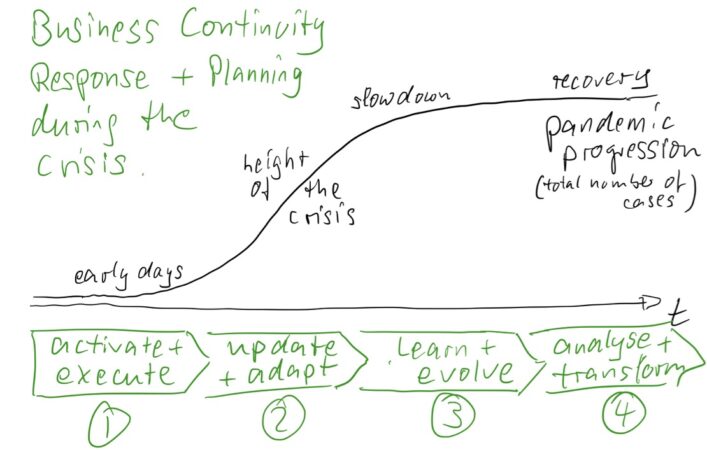
Break the business continuity cycle of panic and neglect
When a significant part of a business’ revenue stream is suddenly compromised, ensuring business continuity takes on number one priority. Business continuity (BC) is defined as the ability to continue business operations during, and after, a disaster or significant unforeseen event. While well-prepared businesses are executing on their BC plans, those less prepared must still prepare for after the crisis and seize the opportunity to learn from current events.
As the COVID-19 crisis presents existential challenges, business continuity (BC) becomes the number one priority. BC is the ability to continue business operations during, and after, a disaster or significant unforeseen event. While well-prepared businesses are executing on their BC plans, those less prepared must still ensure that they are viable post-crisis, and seize the opportunity to learn from current events.
For example, as many businesses seek to reduce cost and off-load staff, it is important to avoid the loss of key expertise required to restart after the crisis. In addition, businesses must realise that business continuity is a systemic issue that includes upstream and downstream partners. It is thus paramount that business leaders communicate closely with key suppliers and customers to ensure their survival as well.
Finally, the COVID-19 crisis presents an opportunity to learn and prepare for future crises. Experts predict that this is not the last event of this nature, so businesses can now make the first steps to creating a BC plan for the future in order to break the cycle of panic (in the face of crisis) and neglect (when the world returns to normal).
The COVID-19 crisis presents existential challenges for many businesses, large and small. Some are directly affected by government-imposed restrictions, such as the Australian airlines which have suspended all international operations in the face of the recent travel ban. Others grapple with changes in customer demand, restrictions imposing social distancing, or enforced shutdowns.
In our most recent episode of The Future, This Week, we talked to Adam Kamradt-Scott, Associate Professor in the Department of Government and International Relations at the University of Sydney. Adam is an internationally regarded expert in global health security and was involved in Australia’s readiness testing for future flu pandemics. Adam shared his insights on Australia’s pandemic response and talked, among other things, about the preparedness of the Australian business community. The following insights combine what Adam what had to say with my own thoughts.
Retain key staff during the crisis
One of the most pressing issues for many businesses in these early stages of the pandemic, when revenue breaks away, is to reduce cost. For many businesses, in particular in the service sector, wages are the largest fix cost position. A natural and often existential response is to reduce staff numbers. We have just seen Qantas and Jetstar stand down two-thirds of their workforce for at least two months, and Tiger Air lay off all its 220 pilots permanently. Other sectors, in particular small businesses, will likely follow, many letting go of casual workers or terminating contracts.
However, such moves can easily result in overreactions and present rather short-term solutions with long-term ramifications such as the loss of expertise. As Adam points out:
“I think it’s going to be really important for those businesses that are taking these measures like Qantas, like Virgin and other airlines, if they’re stopping services, that they obviously want to continue to ensure that they retain that critical knowledge and expertise. That keeps their businesses operational and which will allow them to then recommence operations as soon as practicable.”
It is thus important that businesses carry out a risk assessment of capabilities, skills and expertise before laying off staff, and that they explore creative options to retain their workers. For example, after Qantas announced its temporary lay-offs, Woolworth offered to provide a large number of Qantas staff with short-term casual work opportunities giving them a life-line potentially preventing them to look for other job opportunities. Woolworth is grappling with the other side of the crisis response, an unprecedented surge in demand due to panic buying and people preparing for a looming lock-down.
Other options include to look out for government help or grants that will help keeping critical people on staff without compromising the business’ cost position. Interestingly, the UK government recognised this important problem first and announced to pay up to 80% of workers’ wages “for staff who are kept on by their employer”. Australia has since made a similar move, albeit not as generous, and introduced its JobKeeper program.
Communicate with your business partners
Another important issue that Adam highlighted was the rather narrow field of vision that many businesses employ when engaging in business continuity planning. In their readiness planning, many worry about their own bottom-line or how their workforce might be impacted by the virus. What they forget is that their customers or suppliers might also be affected, what Adam calls “second or third order effects”:
“That’s one of the real important elements around this whole process of business continuity, you can’t just look at what are the immediate impacts on your workforce, you have to also consider who are the people and the other businesses that we rely on to deliver our business and have they had conversations with them prior to a crisis to work out those arrangements.”
While it is too late for many businesses to prepare for these second and third order effects right now, it is important not to restrict the crisis response to just their own organisation. In fact, communicating with partners upstream and downstream, and organising a joint response, will be key for business continuity, as the survival of key suppliers and customers can be equally important as retaining key staff.
Equally, those partners will have an interest in the survival of your business – for example landlords might be prepared to help out with payments, because it will be more beneficial for them that your business survives rather than having to find a new tenant in a difficult economic environment.
Break the cycle of panic and neglect
Even when a business is not as well prepared as it could be it is important to not just fall into response mode right now, but to look forward and use this crisis for active learning and business continuity planning for the future. According to Adam, one of the biggest problems with crisis response is what he calls the “cycle of panic and neglect”:
“This has been one of the big challenges that we’ve seen now for a number of years. We’ve had this constant cycle of panic, and then neglect. So once a crisis happens, everyone panics about it tries to work out what to do. But then as soon as it’s over, everyone then just goes back to normal and forgets about the implications of the challenges that they were confronted with. And we need to get out of that cycle of panic and neglect.”
Businesses must respond to the crisis, for sure. But they should also use the COVID-19 pandemic to learn and adapt. Why not use some of the under-employed staff members to create a business continuity team that studies the crisis response and formulates learnings and guidelines for future crises while the situation unfolds, rather than having to rely on ‘post-mortem’ recollections later?
Such learnings, and the resulting responses to the crisis, can go as far as fundamental transformations of the organisation’s business model, in order to become more resilient for future crises. But this also means to grapple with important trade-offs, because resilience is often in conflict with efficiency. For example, just-in-time supply chains can reduce unproductive inventory and promise large efficiency gains, but they are highly vulnerable to shocks like we are currently experiencing.
What to do now
With a view to the future, the current crisis provides an important platform to prepare for the next one. The following picture might provide some guidance as to how to organise a concurrent response and planning process:
- Activate & execute: Those businesses with an existing Business Continuity Plan will have activated this plan and execute against its recommendations.
- Update & adapt: No plan is perfect, it needs constant adaptation as the crisis response is under way. But this is also the phase in which businesses without an existing plan, while grappling with the crisis, will want to put in place a team to derive learnings for a future one.
- Learn & evolve: In any case, plans and the organisation will have to evolve in response to the crisis. Documentation of learnings is key.
- Analyse & transform: the better the crisis response, what worked and what didn’t, is documented, the better the business is able to transform its operations to increase future resilience, and create a better plan for the next crisis.

Listen to The Future, This Week with Adam Kamradt-Scott
This is part of a series of insights related to Coronavirus (COVID-19) and its impact on business.
Image: Adhitya Andanu from Pexels
Kai Riemer is Professor of Information Technology and Organisation, and Director of Sydney Executive Plus at the University of Sydney Business School. Kai's research interest is in Disruptive Technologies, Enterprise Social Media, Virtual Work, Collaborative Technologies and the Philosophy of Technology.
Share
We believe in open and honest access to knowledge. We use a Creative Commons Attribution NoDerivatives licence for our articles and podcasts, so you can republish them for free, online or in print.





